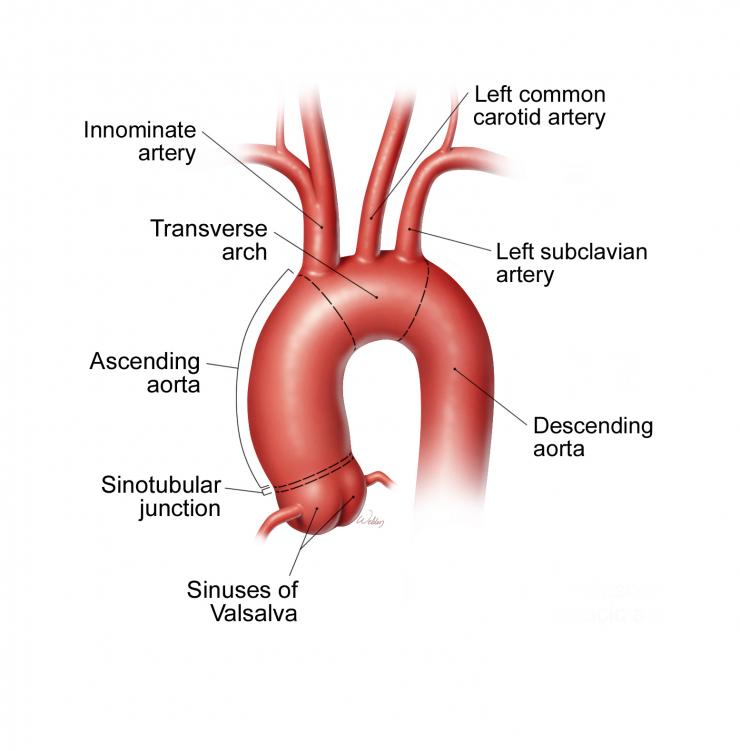Anatomy
The aorta is a tube-like structure that resembles a candy cane. The thoracoabdominal aorta starts after the curve of the cane and extends past the arteries that deliver blood to the stomach, intestines and kidneys.
What Is a Thoracoabdominal Aortic Aneurysm?
An aneurysm refers to ballooning out of the aorta which causes aortic wall weakening. The aorta may continue to further expand (dilate) or remain unchanged, but close surveillance is necessary. As the aortic wall continues to expand, it weakens and with this comes the risk of the wall tearing or dissecting and ultimately rupturing.
What Contributes to the Formation of an Ascending or Aortic Arch Aneurysm?
- Age and/or degenerative disease of the aortic wall
- Uncontrolled high blood pressure
- Long-term use of tobacco
- Inflammation or swelling of the aorta (aortitis)
- Infection
- Past medical history of connective tissue disorders, such as Marfan syndrome, Ehlers-Danlos syndrome or Loeys-Dietz syndrome
- Trauma
Signs of an Aneurysm
Individuals with thoracoabdominal aortic aneurysms usually do not have symptoms. Aneurysms are commonly found incidentally. It is possible that as the aneurysm enlarges and compresses surrounding nerves or organs, an individual may experience back or abdominal pain.
Patients that experience sudden symptoms such as chest or back pain, characterized as a tearing sensation, nausea, vomiting, a fast heart beat and possibly the feeling of impending doom, may be experiencing a tear or dissection of the aorta. Left untreated this can lead to rupture and is considered an emergent condition that requires immediate intervention.
Diagnostic Evaluation of an Aneurysm or Dissection
A computed tomography or CT scan with or without contrast is the most common imaging study used to evaluate your condition. A CT scan provides valuable information about your aorta, such as the location and size of an aneurysm or dissection. Magnetic resonance imaging (MRI) or magnetic resonance angiography (MRA) is another imaging modality to visualize your aortic aneurysm and vessels. Similar to a CT scan with contrast, an MRI or MRA provides detailed information about your aorta. Your surgeon will choose the best method for imaging your aorta.
Incision site (left), and completed surgical repairs of thoracoabdominal aneurysm (right). Illustration by Scott Weldon.
Surgical Repair of the Aorta
During this operation, the surgeon will make an incision on your chest beginning under the left shoulder blade and extending around to the abdomen.
Depending on the extent of your aortic surgery, you may be placed on a pump to assist in the circulation of your blood. During your surgery, the diseased portion of your aorta will be replaced with a flexible tube or graft made of Dacron®. Additionally, depending on the condition of other connecting arteries, it is possible you may also require additional smaller grafts to replace vessels that supply blood to other organs.
A unique risk of this particular surgery is paralysis of the legs. To help prevent this from happening, a very tiny drain will be inserted into your spine by the anesthesiologist after you are asleep. This drain is usually removed within 48 hours after surgery. You will remain in the ICU until the drain is removed.
Recovery
It will take you approximately two to three months to fully recover from undergoing thoracoabdominal aortic aneurysm surgery. You should plan to be away from work, getting your full strength back, for approximately eight weeks. Your surgeon will advise you on post-operative restrictions and when it’s safe to drive again. Participation in a cardiac rehabilitation program will be beneficial in your recovery. Make sure to ask about this before you are discharged from the hospital so arrangements close to your home can be made in advance.








 Credit
Credit

